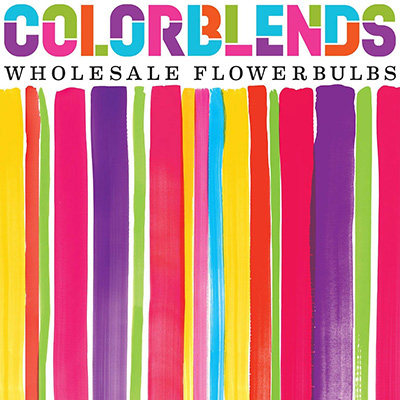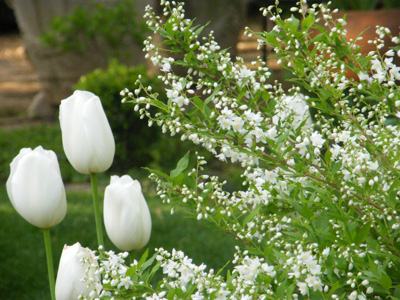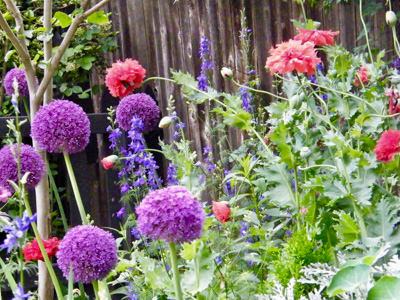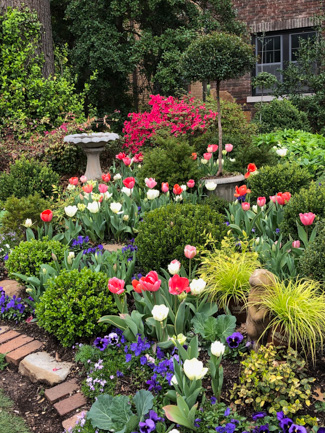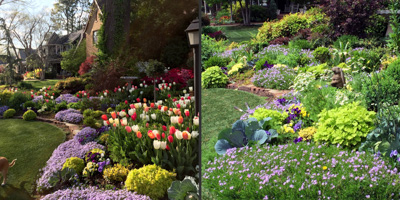Linda Vater
Design Notes
White-on-White Combo
Combo: A white-blooming theme anchored by: Deutzia gracilis (slender deutzia) with Tulipa ‘Maureen’ (single late tulip). Unseen companions include: perennial Dianthus; ferns; Solomon’s seal; Colorblends Tulip Blend White Cubed™ (three white tulip varieties that bloom in sequence, with overlap, early-mid through late season); snowball viburnum; Viburnum ‘All that Glitters’® and Viburnum ‘All that Glows’® (smaller viburnums with glossy foliage that cross pollinate to form shiny blue berries in fall).
Location: Linda’s garden in Oklahoma City, Oklahoma, USDA Zone 7a
Notes: My back garden is a cool oasis enveloped by mature trees and layers of greenery. In spring, it is brightened by white flowers for a look I call “wedding season”. Here, large-flowered Tulipa ‘Maureen’ is paired with small-flowered Deutzia, a partnership that holds center stage for two or more weeks in late spring (Oklahoma’s erratic spring weather permitting). Tip: to get Deutzia to bloom next spring and control its size, cut it back hard a week or two after it blooms.
Biannual Color Reboot
Combo: Year-round: Buxus x ‘Green Mountain’ (conical boxwoods); Heuchera (golden green); variegated English ivy; and Lamium. Add in May: shade-loving annuals. Add in fall (and seen here): ornamental kale (yellow flower spikes); pansies (azure blue); violas (blue) and tulip bulbs. The blooming tulips are Colorblends Gentle Giants® blend (soft pink and peach, blooms midseason).
Location: Linda’s garden in Oklahoma City, Oklahoma, USDA Zone 7a
Notes: This window box on our front facade functions as a year-round container garden with good bones and thriller/filler/spiller components. There’s a fairytale synergy to the mix of boxwoods and tulips with blue and gold accent plants and green trailers. It’s designed to perform 12 months of the year, with a biannual color reboot. Naturally, it’s most fun to choose the reboot’s couleur de la saison.
In October, I add cool-season annuals and spring bulbs to carry the box through fall, winter and spring. In spring, of course, tulips are the divas, so the bulbs are planted densely, shoulder to shoulder, across the back of the box. This blend of pink and peach tulips adds subtle complexity without making the entire combo too busy. By late spring, as heat arrives, I pull the spring bulbs, kale, pansies and violas and add shade-loving, summer annuals. Tip: for year-round window boxes, choose permanent plants that transition well from a full-sun winter exposure to a shaded summer environment.
Playful Mix with Alliums
Combo: Allium ‘Globemaster’ (pinkish lilac); larkspur (blue, variety unknown); pepperbox poppy (coral pink, variety unknown).
Location: Linda’s garden in Oklahoma City, Oklahoma, USDA Zone 7a
Notes: Design is one thing. Experimentation is another and nothing is more fun to experiment with than alliums! Here, the 8-inch orbs of Allium ‘Globemaster’ are joined by voluptuous, coral-pink poppies and smaller-flowered, periwinkle-blue larkspur. I love this combo. There’s an unexpected lightness to its interplay of color, texture and bearing. The alliums are perennial here. The anonymous poppies and larkspur are self-seeding annuals, both unknown varieties, gifts from friends
Tips: In my heavy clay soil I include a healthy dose of grit in each planting hole, and try not to overwater this area in the summer. Unsightly allium foliage can be masked by other plants that mature later, including: clumping sedums, tall phlox or rosemary. Pots of seasonal color can be plopped into beds to distract the eye when hot and buggy conditions make getting other transitional transplants difficult to establish.
Car-Stopping Spring Display
Combo: Two Colorblends tulip blends: Smooch™ (2 varieties, pink and deep rose, blooms in the early-mid season) and Vidal™ (5 varieties, white and cream with green accents, blooms early-mid through late season). Boxwoods: Buxus microphylla japonica ‘Baby Gem’™ and ‘Winter Gem’; and Buxus ‘Green Mountain’. Gold-leaved plants: Euonymous fortunei ‘Gold Splash’® (variegated); Ligustrum sinense ‘Sunshine’ (aka golden vicary privet); Carex EverColor® ‘Everillo’ (grasses); and Tanacetum parthenium ‘Aureum’ (golden feverfew). Notable among other plants: Phlox subulata ‘Emerald Blue’ (creeping phlox); chamomile; columbine; cabbage; black-seeded Simpson lettuce. Standards in pots: Eugenia (Australian brush cherry, these overwinter in a greenhouse).
Location: Linda’s garden in Oklahoma City, Oklahoma, USDA Zone 7a
Notes: In spring, the neighbors slow down to take in the color of this front garden. I plant up to 800 bulbs each fall and like to switch things up, just for fun. This time, I picked two separate tulip blends: one blooms in the early-mid season (pinks) and the other nearly all season long (whites). I don’t mix the two blends together—they’re planted adjacent to one another and sometimes crossed over. Once the spring color fades, I pull out the tulip bulbs and cool season annuals to let the lush summer growth fill out.
To make a real statement with tulips, forget the idea of planting one bulb per hole—plant them en masse, in large holes that hold large clusters of bulbs. This method also helps when planting under trees, where root-bound soil can be an issue and additional coverage soil may be needed.
Colorful Spring, Subdued Summer
Combo: Left: Late spring: Tulipa ‘Maureen’ (white); Colorblends Tulip Blend French Blend Rose™ (pink, rose and apricot), blooms late season); and Phlox subulata ‘Emerald Blue’ (creeping phlox) with deep rose azaleas, boxwoods, early-emerging perennials and pockets of blue, purple, yellow and white pansies and violas. Right: by early May the tulips and cool season annuals are gone. A subdued summer palette of greens, blues, gold and mahogany takes over to cool things down and the mature trees shade the area.
Location: Linda’s garden in Oklahoma City, Oklahoma, USDA Zone 7a
Notes: Summer heat and drought make routine watering a must for this southern exposure. After bloom, bulbs are pulled out before summer watering turns them to mush.
In spring, the rabbit statue invites design ideas. In this montage of cabbage and black-seeded Simpson lettuce we see an edible aspect that speaks to “the story” of the rabbit, while surrounding chamomile, creeping phlox, golden feverfew and purple columbine introduce a wildflower look that’s eminently bunny friendly. Soon, maturing larkspur, foxglove, daisies, Heuchera and Sedum will gain size to fill in the voids where tulips once stood. As the tree canopy fills out, what was once full sun becomes full shade to meet the challenge of Oklahoma’s skyrocketing temps.
